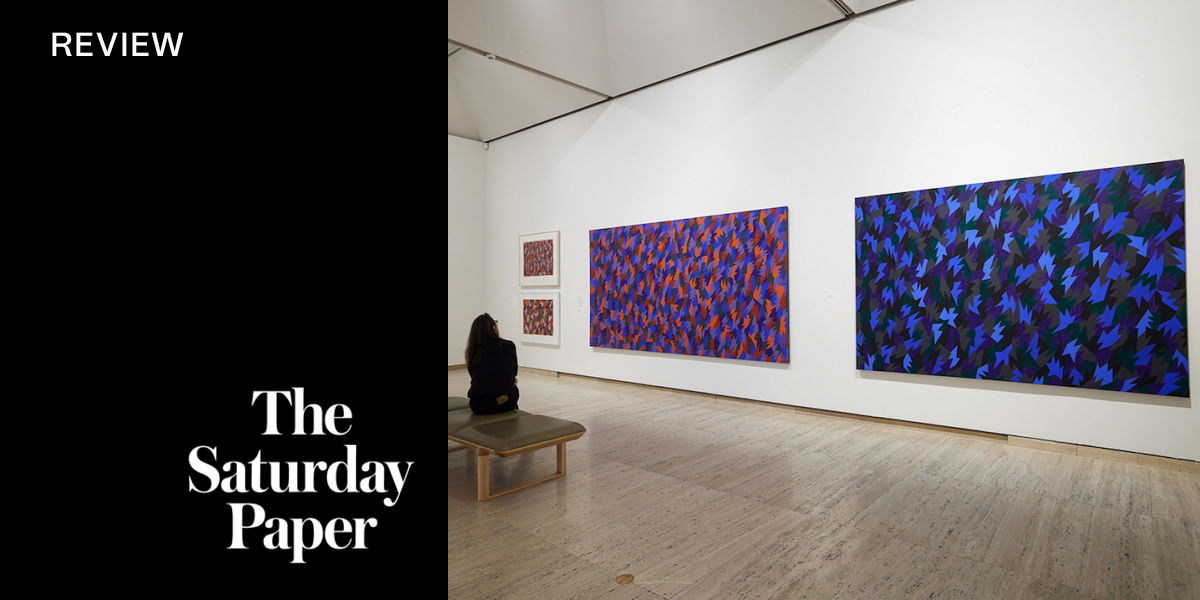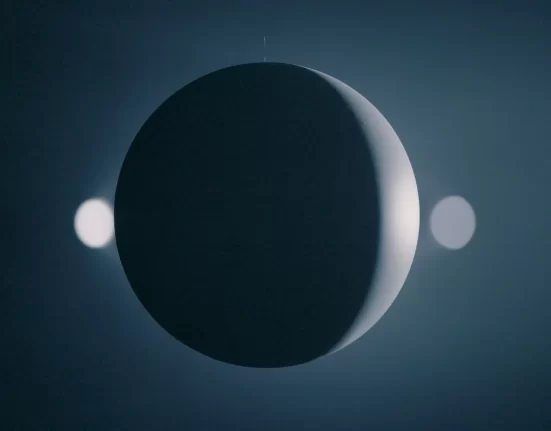The painting creates its own atmosphere. Bands of colour shimmer across a canvas, vying for my attention. First hot pink, like the last traces of a sunset. Then the golden orange of high summer, when it’s so hot and bright that surfaces become radiant. Finally, a calm green creeps across my retina, growing more intense as if it possesses its own life force, taking over the image as I step sideways from left to right.
I move in the other direction and the green recedes, like a fern retracting its fronds before I notice. Next to me, a couple is performing the same shuffle, trying to locate the source of the painting’s magic. The work seems to be asking, can you trust what you’re looking at? And when the illusion is this pleasurable, does it matter at all?
This painting is Solstice, a monumental 1974 work by Lesley Dumbrell, one of Australia’s great abstract painters. It commands the first room of Thrum, a survey exhibition curated by Anne Ryan at the Art Gallery of New South Wales. Next to Solstice hangs Capricorn (1975), a sequence of purple and green waveforms that, when you step back, pulse and undulate. It’s a painting you can almost hear, each line meticulously applied with a fast-drying acrylic paint called Liquitex.
In the decade before Dumbrell painted Solstice, she taught painting at the Prahran College of Advanced Education. She discovered the work of Bridget Riley, the British artist who used lines, squares and circles to show us how we see, and invented careful tonal rhythms to make her pictures vibrate. Solstice reflects, in miniature, the question Dumbrell grappled with for the next five decades – whether rigid geometries and precise systems could put us more deeply in touch with our emotions, to reveal the bridge between the fleeting sensations that live inside us and the external world.
I visit Thrum on a gloomy Sunday afternoon. On the lower level two of AGNSW’s south building, Naala Nura, people throng into the Archibald in groups, jostling to appraise their favourite celebrity likeness. Across the atrium, viewers move through Thrum in ones and twos. They appear to be locked in private states of joy and contemplation, puzzling – as I am – over the accumulated power of Dumbrell’s canvases. These are paintings as a form of time travel, in which energy expressed decades ago acts upon a body in the present day.
Dumbrell is 82. Thrum, which spans four rooms and more than 90 works – many seen together for the first time – is, remarkably, her first survey at a state art museum. Dumbrell decided to become an artist as an eight-year-old struck down for three months with polio, and her best works possess an imaginative intensity – a sense of close looking that never quite left her.
She was part of a cohort of artists, including Sydney Ball and Robert Jacks, who in the 1960s pioneered colour-field painting in Australia. The show opens with two hard-edged abstractions, both from 1969: Promontories, a series of interlocking triangles, and Red Shift, in which squares of violet and red appear and disappear. They pre-date an obsession with the psychological effects of colour and pattern – how they can shape our sense of space, lift or lower our mood – that would last a lifetime.
Dumbrell helped establish the Women’s Art Register, the community that galvanised Australian women artists. They were encouraged by the American art critic Lucy Lippard, whose 1975 visit shifted the course of the country’s feminist art history. Dumbrell was famously excluded from The Field, the 1968 exhibition at the National Gallery of Victoria that introduced non-objective art to the Australian public. But using this narrative to frame Dumbrell’s work speaks to how the Australian art world fixates on the same stories. This myth-making erases histories of abstraction practised by First Nations and non-Western artists on this continent.
More interesting, to my mind, is how Dumbrell sustained her single-minded inquiry over decades, turning over problems of line, shape and composition again and again despite motherhood, relocations and rises and falls in critical attention. Her father was an architect and one of the pleasures of this show is the opportunity to pore over her drawings, precise studies made on gridded paper, mathematical equations visible in pencil. As a child, she explored the creeks and paddocks around her home in Balwyn. In Thrum, I’m struck again and again by how she imposes order on sensory experience to transform it, reassembling for the viewer how it feels to be in relationship with the world.
How do you look at a Dumbrell painting? In the show’s second room, I’m mesmerised by a triptych titled February (1976) that unfolds across a wall for nearly five-and-a-half metres. At the time the artist was living near Port Phillip Bay, watching the clouds drift, the sky change. In this work, rows of diagonal lines hover over the canvas at various angles. I train my eye on yellow and see blue. I notice that these dashes are vectors that move upwards, pushing the painting into motion, how watching the horizon can make you sense the passing of time in ways that are imperceptible.
In Sandcastles (1979), marking the start of the third room, she is freer and looser, the lines and dashes further apart, as if she’s found permission to play. Across the space, Tramontana (1984) – Italian for a cold wind – is a patchwork of zigzag shapes that wobble and dance, the way the breeze animates autumn leaves. Beside it a pair of small paintings – Astrolabe 1 and 2, from 1983 and ’84 respectively, named after the medieval instrument that was once used to chart the stars – are charged with electricity. Like atoms reacting in space, jagged forms in lime, indigo and lavender bounce against each other.
In 1990, Dumbrell moved to Bangkok having reunited with her first husband. Works from this era – such as Indochine 2 (2003), a study of red – feel less emotive, as if the artist’s intimacy with her subject has shifted. In 2008, Dumbrell began living between Thailand and Australia, spending part of the year in the Strathbogie Ranges, north-east of Melbourne. Her gaze once again intensifies, fractals and rhizomes reflecting the patterns that flourish in nature. In Columbine (2008), part of Thrum’s final room, lines bisect tightly, crisscrossing each other from different directions. It’s a painting I feel as though I can walk into: the canvas is now a portal, the painting reads like a sculpture. An illusion I can believe in, because Dumbrell is showing me the way.
Lesley Dumbrell: Thrum is at the Art Gallery of New South Wales until October 13.
This article was first published in the print edition of The Saturday Paper on
August 24, 2024 as “The colours of magic “.
For almost a decade, The Saturday Paper has published Australia’s leading writers and thinkers.
We have pursued stories that are ignored elsewhere, covering them with sensitivity and depth.
We have done this on refugee policy, on government integrity, on robo-debt, on aged care,
on climate change, on the pandemic.
All our journalism is fiercely independent. It relies on the support of readers.
By subscribing to The Saturday Paper, you are ensuring that we can continue to produce essential,
issue-defining coverage, to dig out stories that take time, to doggedly hold to account
politicians and the political class.
There are very few titles that have the freedom and the space to produce journalism like this.
In a country with a concentration of media ownership unlike anything else in the world,
it is vitally important. Your subscription helps make it possible.








